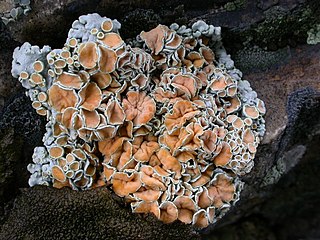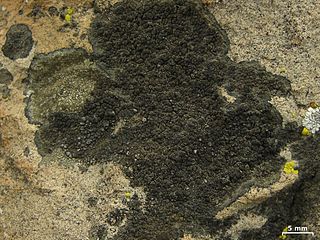
The Sonoran Desert is a hot desert in North America and ecoregion that covers the northwestern Mexican states of Sonora, Baja California, and Baja California Sur, as well as part of the southwestern United States. It is the hottest desert in both Mexico and the United States. It has an area of 260,000 square kilometers (100,000 sq mi).

The Chihuahuan Desert is a desert ecoregion designation covering parts of northern Mexico and the southwestern United States. It occupies much of far West Texas, the middle to lower Rio Grande Valley and the lower Pecos Valley in New Mexico, and a portion of southeastern Arizona, as well as the central and northern portions of the Mexican Plateau. It is bordered on the west by the Sonoran Desert, the Colorado Plateau, and the extensive Sierra Madre Occidental range, along with northwestern lowlands of the Sierra Madre Oriental range. Its largest, continual expanse is located in Mexico, covering a large portion of the state of Chihuahua, along with portions of Coahuila, north-eastern Durango, the extreme northern part of Zacatecas, and small western portions of Nuevo León. With an area of about 501,896 km2 (193,783 sq mi), it is the largest hot desert in North America. The desert is fairly young, existing for only 8000 years.

Buellia is a genus of mostly lichen-forming fungi in the family Caliciaceae. The fungi are usually part of a crustose lichen. In this case, the lichen species is given the same name as the fungus. But members may also grow as parasites on lichens (lichenicolous). The algae in the lichen is always a member of the genus Trebouxia.
Caloplaca durietzii, or Durietz's orange lichen, a smooth surfaced yellowish orange crustose areolate lichen with elongated lobes that grows on wood or bark in southwestern North America. It is commonly seen growing on old junipers in Joshua Tree National Monument in the Mojave Desert. It is in the Caloplaca fungus genus of the Teloschistaceae family.

Buellia spuria, the disc lichen, is a white to light ashy gray crustose areolate lichen that grows on rocks (epilithic) in montane habitats. It has a black edge from the conspicuous, more or less continuous prothallus, which can also be seen in the cracks between the areolas forming a hypothallus, and in sharp contrast with the whitish or ashy colored areolas. It prefers mafic (siliceous) rock substrates. In Joshua Tree National Park is can be seen on vertical granite and gneiss faces in washes. It is common worldwide in the Northern Hemisphere. It is very common in the Sonoran Desert from southern California to Arizona, Baja California, and Sonora, Chihuahua, and Sinaloa, Mexico.

Rhizoplaca chrysoleuca is a pale yellowish-green to gray-green umbilicate foiliose lichen in the Lecanoraceae family. It was first described in 1791 by English botanist Sir James Edward Smith as Lichen chrysoleucus; Friedrich Wilhelm Zopf transferred it to the genus Rhizoplaca in 1905.

Buellia abstracta is a crustose lichen.

Buellia disciformis, the boreal button lichen, is a thin, bluish to pale gray rimose to areolate crustose lichen that grows on bark in temperate forests in the northern USA and Europe, and at high altitudes in Arizona, down to 500 metres (1,600 ft) in coastal areas of California. Flat apothecia with black discs are .2-.7 mm in diameter and sessile, with noticeable lecideine margins. Lichen spot tests are negative except for K+ yellow. Secondary metabolites include atranorin, fulgidin, and sometimes traces of fulgoicin and norfulgoicin. B. erubescens is similar and more often found on wood than the bark loving B. disciformis, and has smaller spores.

Buellia badia, the parasitic button lichen, is a dark chocolate-brown crustose areolate lichen of Europe, northern Africa, and North America that starts as a parasite growing on other lichens, such as Aspicilia phaea, gradually then becoming independent growing on rock (sometimes also on hardwood. Areoles may be contiguous or dispersed. Lecideine apothecia are 0.3 to 0.9 mm in diameter with black discs, that are initially flat, then become strongly convex as they age. Lichen spot tests are all negative. There are no known secondary metabolites as of. It is similar in appearance and other ways to the chocolate brown Dimelaena californica, which also starts off as a parasite on other lichens, and has spores of similar shape, size, and internal construction. D. californica has not been found on wood, is more preferential as to the lichens it starts growing on, and commonly has norstictic acid as a secondary metabolite. Some think they should be included in a new, third genus.
Buellia concinna, the cinnabar button lichen, is a pale yellow to greenish or brownish bullate (bubble-like) to granular crustose lichen that prefers siliceous rock and cliff faces in temperate to subarctic, subalpine and alpine climates throughout the Northern Hemisphere. In North America, it prefers higher altitudes such as in the Sierra Nevada range. Lecideine apothecia are sessile on the thallus and are .2–.8 mm (0.0079–0.0315 in) in diameter with black discs. Lichen spot tests are C+ orange or pinkish, K+ yellow, KC− but CK+ orange, and it is UV+ yellow to ultraviolet light. Secondary metabolites include arthothelin, isoarthothelin, 6-O-methylarthothelin, 4, 5-dichloronorlichexanthone, 4, 5-dichloro-6-O-methylnorlichexanthone, asemone, thiophanic acid, gyrophoric acid, lecanoric acid, and orsellinic acid.
The Philip L. Boyd Deep Canyon Desert Research Center is one of the original seven of the total 39 sites in the University of California Natural Reserve System. It contains lands originally donated to the University by regent Philip L. Boyd in 1958. The Research Center is contained within UNESCO's Mojave and Colorado Deserts Biosphere Reserve.
Thomas Hawkes Nash III is an American lichenologist. His research is about the biology and ecology of lichens, and the effects of air pollution on plants and lichens. He is known as an authority on the family Parmeliaceae. During his long career at the Arizona State University, he helped develop the lichen herbarium into a world-class collection with over 100,000 specimens representing more than 5000 species. In 2010, the year of his retirement, he was awarded the Acharius Medal for lifetime achievements in lichenology, and the following year had a Festschrift published in his honor.
Buellia arida is a species of saxicolous (rock-dwelling), crustose lichen in the family Caliciaceae. It occurs in Australia. Buellia arida grows up to 4 cm wide, either concealed within or visible on rock surfaces, forming small, fragmented patches. It features an off-white, dull thallus, numerous black apothecia that become convex over time, and spores that evolve from pale to dark brown, characterized by their ellipsoid shape and finely decorated surface.
Buellia cravenii is a species of saxicolous (rock-dwelling), crustose lichen in the family Caliciaceae. It is found in Australia. The lichen spreads up to 3.5 cm wide thick, forming a continuous, grey-white cracked pattern of areoles.

Buellia oidalea is a species of crustose lichen found along the Pacific coast of North America, from Coos County, Oregon to Baja California Sur.
Buellia nashii is a species of lichen characterized by its crustose thallus, typically found in the Sonoran Desert Region and adjacent areas. It was first described by Bungartz et al. The species is named in honor of Dr. Thomas H. Nash III, a notable lichenologist and the Ph.D. supervisor of the author.
Buellia stellulata, commonly known as the disc lichen) is a species of crustose lichen that is widely distributed throughout the Northern Hemisphere.

Buellia griseovirens is a species of lichen belonging to the family Caliciaceae. It exhibits a crustose growth type and is commonly found on well-lit, smooth bark, and worked timber surfaces. The species can tolerate moderate pollution.

Buellia aethalea is a species of lichen that belongs to the family Caliciaceae. It is commonly known as darkened button lichen, and Buellie noircie in French. The lichen's familiar nickname is inspired by the appearance of its surface, adorned with small black spots reminiscent of buttons.











